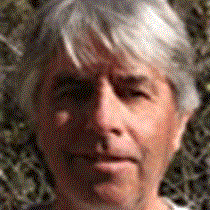Fog and mist drifted through the mountains, enveloped the rain forest, softened the landscape, and dampened the hair of early morning bow watchers as we cruised to Thomas Bay and Cascade Creek. This morning’s adventure would be a hike to a massive, brawling waterfall a few hundred yards up a roaring creek from the beach, then onward up the narrow boardwalk steps into the dripping rain forest. Clouds of mist streaming from the thunderous waterfall beaded on our faces while we marveled at this amazing spectacle.
The mature, old-growth spruce and hemlock rain forest here appears somewhat different than the emerging forest we walked in yesterday at Williams Cove although they are essentially the same, differing fundamentally only in time of development. Given a few hundred more undisturbed years, the forest at Williams Cove will look like the one here at Cascade Creek. Old-growth forests provide substantially more habitat and food resources for wildlife than younger mono-culture emerging forests so preservation of at least some old-growth remains critical to the preservation of wildlife species that depend on them, such as the delightful yet elusive rough-skinned newt discovered alongside the trail, one of Alaska’s very few amphibian salamander species.
Dripping wet, mud on our boots, but with smiles on our faces, we gratefully boarded the inflatable boats to return to the ship for hot chocolate and a superb presentation on photography tips and techniques from our onboard photo instructor Sharon before another excellent lunch.
Petersburg, named for its founder Peter Buschman in the late 1800s, boasts the third-highest production of seafood product in Alaska, trailing only Kodiak and Dutch Harbor. A charming fishing community of about 3,000 hardy folks, Petersburg’s Norwegian heritage is readily apparent. Ice flows drifting in the waters around Petersburg calved off North America’s southernmost tidewater glacier – nearby LeConte Glacier – providing the original fisherman settlers ice to keep their product fresh, giving them a marketing advantage over those fishing communities that had to rely on salting to preserve their catch. From these humble beginnings, Petersburg grew to the major fishing port it is today!
While the area offered an excellent natural harbor, outstanding fishery, and LeConte Glacier ice to keep the catch fresh, the land itself consists mostly of unstable muskeg peat bogs. Muskegs, while a challenging place to build, remain fascinating environments exhibiting specialized plants unique to the acidic wetness of the bog. We hiked through one of these distinctive ecosystems in diminishing rainfall to study and learn about this different yet remarkable landscape of the Southeast Alaskan forests. Following the bog walk, a dock walk highlighted the fishing boats and different fishing techniques used by commercial fishermen in Southeast Alaska.
A Dungeness crab feast followed the evening re-cap and social hour, highlighted by short presentations on fisheries management by Jason and raindrop photography by Sharon. Filled full of delicious fresh crab, we adjourned to the lounge for dessert and to hear delightful stories from Tamsen, one of our local Alaskan naturalists, about the different and distinct experience growing up in Alaska provides.









